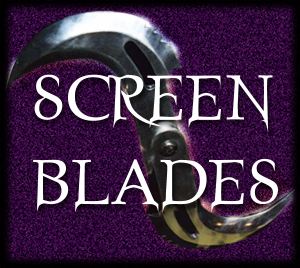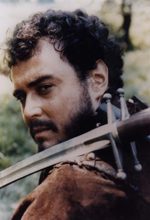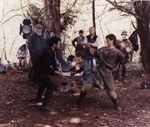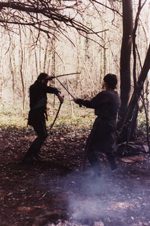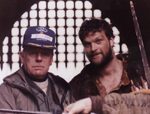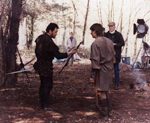SWORD CHOREOGRAPHY IN MOVIES AND TV conversations with Bob Anderson, Anthony De Longis, F. Braun McAsh, Mark Ryan, Tony Swatton and Terry Walsh By Abbie Bernstein PART 2 "I approached [ZORRO] producer Doug Claybourne," De Longis recalls. "He said, ‘Why should I hire you instead of somebody else?’ I went off and I thought about it. I wanted to come up with a Spanish style and I looked back through history and found [the Mysterious Circle], one that nobody knew very much about, because it was so eclectic and so complicated. I started realizing, ‘Wait a minute, there are a lot of similarities to things that I’ve studied, particularly the Filipino arts." De Longis studied for five years with Filipino master martial artist Dan Inosanto; he now teaches an acting action workshop at Inosanto’s Los Angeles academy. "The Spanish occupied the Philippines for 800 years; there had to be a bleed-over. So you had two cultures that were both cultures of the blade looking at each other’s style and absorbing what was useful."
The Mysterious Circle takes its name from a grid drawn on the floor that brings opponents into close proximity with one another. The lines on the grid dictate patterns of movement for the combatants. "Suddenly these patterns on the floor are starting to make sense," De Longis remembers. "This is a training device. It’s not just the pattern on the floor – the pattern moves up three-dimensionally to go through the torso through the upper body to the weapon, so the lines are not only the most direct route back to your opponent’s vitals, it’s also positions of where the parries go. What you’re essentially doing is building a barrier around yourself that no one can penetrate, and that as soon as you contact somebody’s weapon, it acts as a guide back to them. What I liked about it was, [the Circle] gives you an automatic sense of danger, because everything is so close. The other thing was, by being in such proximity, it was going to allow for more interesting coverage. It’s a style we’ve never really seen on film before. I worked with a couple of other guys and put together some things showing how this could visually before our very eyes change a guy who’s a simple bandit into a figure of legend who’s capable of incredible things. One of my favorite things in movies has always been the training sequences – it’s sort of the character’s journey in microcosm. I got to go in and present to Robert Rodriguez – and then three days later he left the project." When Martin Campbell came in to direct ZORRO, Bob Anderson was hired as the film’s sword master. Although they were different from De Longis’ notions, training sequences did find their way into the adventures of Anthony Hopkins’ Don Diego and his pupil Alejandro (Banderas). In fact, it’s possible that the film’s writers – along with Hopkins – may have gotten a few ideas from watching Anderson during rehearsals. "The writers probably came round and watched me training [the actors] and got ideas from that," Anderson allows, "but the script is not very explicit when it comes to physical action. All they need to do is just say, ‘Fight occurs.’ I think it was on RETURN OF THE JEDI that one of the actors said, ‘In the script it’s about five minutes, but on film, it’s five days,’ rehearsing and shooting it. They do give generalities of where the fight should go, and they may say that [the characters] swing on the chandelier or land on a table or fight through the hallway, and I pay attention to that, and then I fit in the technical aspect of the swordplay. [Director Martin Campbell] watched rehearsals and made suggestions: ‘This is too long’ and ‘You want to tighten it up a bit,’ but the general training of the actors and the choreography of the fight was left to me. They used to [shoot the whole fight in a master shot] in the old days, but I found that extremely difficult, because some of the fight sequences were very long, and impossible to learn and remember from start to finish. I trained the actors in maybe five sequences. And eventually this is the way they shoot it – Martin Campbell would pick out his camera angles and shoot it in sequences." Meanwhile, De Longis found another use for the Circle. HIGHLANDER star Adrian Paul had been greatly impressed with De Longis when the latter had guest-starred as the nemesis of Paul’s Immortal Duncan MacLeod in the Season 3 episode "Blackmail." De Longis’ Kurlow was (not surprisingly) beheaded by MacLeod, but Paul hoped that the adept fencer could be brought back as another character.
HIGHLANDER show runner David Abramowitz encouraged De Longis to come in with a story idea. By now, it was Season 5. "I said, ‘Well, I’ve got a style,’ " De Longis relates. "I came up with a couple story ideas. ‘Well, we’ve done that one,’ because they’d done a hundred by then – ‘we’ve done that one – oh, that’s kind of interesting. Say, I like that.’ " De Longis appeared in the episode ‘Duende’ as Otavio Consone, Duncan’s one-time mentor in the art of the Mysterious Circle, now his mortal foe. "I gave them all my notes, because I wanted to inspire the writers. Unfortunately, [‘Duende’] kept me out of town while Bob Anderson was in town casting for sword fighters [for ZORRO], so I didn’t even get to work with him, but it turned into one of the most challenging and rewarding opportunities of my life."
In less skilled hands, the climactic fight had the potential for disaster. When it came time to shoot the scene, rain was pelting down, rendering the ground treacherous. "We were slipping and falling, it was very hazardous," De Longis recalls, "but production value-wise, it was extraordinary. It was gorgeous. What I liked about it was, working in that proximity, all of a sudden you could get both people in frame and take advantage of that feeling of, ‘My goodness, they’re awfully close,’ because we are. In ‘Duende,’ we were doing rapier and dagger, too. So being at sword’s distance and then having to manipulate the dagger to come in and capture and manipulate the sword and then get back out, it’s a constant pivoting and shifting and adjusting of distance, which requires a very high level of skill. Fortunately, Adrian has that level. That fight would probably not have been possible if it had been anybody other than Adrian and myself, because there was just no time [to wait for the rain to stop]. He came with his skills and I came with my 20-some years of skills and we just had to walk in front of the camera and start to shoot. Adrian and I trusted each other well enough and were confident enough in each other’s skills that if something happened, we knew we could keep each other safe, and we did." McAsh rates De Longis as one of the best guests HIGHLANDER ever had; he has a few other favorites as well: "Tony De Longis [is] the first person who comes to mind with the greatest amount of knowledge and weapons skills. Valentine Pelka [recurring villain Kronos] had is certified by the British Society of Fight Directors and is extremely good with the sword. David Robb, who played Kalas, was also trained and experience. Peter Wingfield [recurring 5,000-year-old Methos], although he had no experience [since school] with a sword, has been trained with a sword and is very physically adept. Wolfgang Bodison, who played Cord in ‘Brothers in Arms,’ had three fights, two swordfights and a knife fight. He had never touched a bladed weapon in his life prior to being on HIGHLANDER and yet his fights were so good, he had such natural ability and such control over his body that two of his fights are on my [choreography] demonstration reel." McAsh has a high opinion of Paul’s abilities, which allowed for a great range of nuance in the series’ many fights. "Adrian is so good with a sword that he is completely free subconsciously to act the scene to its fullest degree. I can sometimes use Adrian’s skill to mask the lack of skill on the part of an opponent, because Adrian can not only be very convincing as the aggressor, he can also be very convincing as a desperate defender, so he can make the person look a little more vicious than he actually is. The interesting thing with Duncan MacLeod [was that] the character had this code of honor that said not only must he win, but he must win honorably. So Duncan MacLeod, as much as it is physically possible for him to do so, attempts to fight fair. So in the choreography, you can actually show when he has his opponent at a disadvantage but chooses not to use that advantage because it would mean in his mind that he’s not killing the person so much as murdering him. So in some cases, he actually starts a move, stops it, steps back, allows his opponent to recover and they go at it again. Some of the things we did on HIGHLANDER were almost entirely character-driven, as opposed to fight technique."
Anderson has similar esteem for Paul’s merits. "He was extremely well-trained, because I got him every week throughout the series. All I had to do was worry about the new actor who I got three or four days before they actually shoot on him. So took that time to pump as much swordplay into him or her as I could. There would be times when I would ask Adrian Paul to slow down, because Adrian is an extremely excellent actor/swordsman, and he can move exceedingly fast. But the actor who’s coming up could not keep up with that, because he wouldn’t have had the time training." There are times, Walsh says, that training won’t help. "There are some people who will never, ever be able to fence because they just don’t have the right sort of hand and eye coordination. In which case, you get a stunt double in and then just shoot the actor very tight in a just above the chest sort of shot, so you can’t actually see his hand, and then you give him nothing in his hand, and he just makes movements."
De Longis, who has been teaching stage combat and character movement since 1974, agrees there are hopeless cases, but feels that most limitations are self-imposed. "As a teacher, I think one of the reasons that I teach well is that a) it’s important to me to teach well and b) I don’t think anybody has less patience with themselves or has overcome more frustrations than I have, so it makes me very patient. Physically, you have to be realistic – I’m a big believer in, don’t focus on what you can’t do, let’s see what you can do. One of the last [HIGHLANDER] conventions I was at, I [taught a class for] 50 people that I’d never seen before, many of whom hadn’t had a conversation with their body in quite some time. And the last thing I wanted them to do was be competing with the person next to them. By the end of 90 minutes, I had everybody with a stick in their hand and moving and doing drills like they were swords, and their entire body and the weapon were all moving in harmony, and they were very comfortable. I was very happy to see that some people were inspired to go out and continue to work, which is the whole idea. Because when you prove to somebody that they can do something that they were absolutely sure they can’t, then they have to go and re-evaluate the limitations they’ve put on themselves. Part of my process is, I strain that stuff out: ‘Tell you what, I know you can’t do this, so we won’t worry about that. I want you to just try this – this has nothing to do with that.’ Pretty soon, people are going, ‘Hey, you said we weren’t going to do that, I can’t do that – but I’m doing it. Darn, now I’ve got to get a new theory,’ " he adds with a laugh. Anderson cites a common mistake made by newcomers to the sword. "They forget that they’re fencing somebody else. They try and do it on their own, and they’re totally introverting what they’re doing and not considering what the opponent is doing. You can train them out of that by giving them confidence in what they’re doing. And then they relax, and then they start looking at the other guy, and eventually you get stuff which is very believable on the screen."
"Knowing how to handle the weapons does not qualify you to choreograph anything," McAsh cautions. "It simply means you can be choreographed. I studied in England, I apprenticed myself to the Henry Marshall, Master of Arms at the Royal Academy of Dramatic Art. When I was at the Stratford [Canada] Shakespeare Festival for almost five years as an actor, I apprenticed to the fight master there, Paddy Crean. In my last year at Stratford, they allowed me to choreograph four shows, because they were doing so many histories that it was physically impossible for Paddy to do them all." Safety is always of paramount concern. "The hack and bash method is the wrong way," Anderson says. "The right way is to be able to do those moves so that they look dangerous to the audience, but they are not dangerous to the actors. Actors can become very dangerous, because they don’t have the skills of a swordsman who’s been doing it for donkey’s years. They don’t have the physical training or the response speed – things happen very quickly, in a tenth of a second, and you’ve got an eye out if you’re not taught safely. If you’re making a cut, for instance, to your opponent’s cheek, you would make it with all the speed and effort that you would if you were doing it for real, but you know you’re going to get parried. You’re aiming where the sword is going to be, and you contact his sword. But if his parry was not there, you wouldn’t hit the guy in the face. I do a lot of training on pulling at the last millisecond, because if you pull it too much or too early, then it looks phony." "On a stage play, you can get away with looking – there used to be a technique of looking where you’re going to put the sword," Ryan explains. "So if you look there, the guy knows that’s where the sword’s going to go, right? On screen, you can’t do that. If you look at some of the early ROBINs, you’ll see us doing that, you’ll see how we learned to overcome that. Because if you’re in a close-up and you do that, your eyes are going like this," he glances sideways, "whereas you want the eye contact. It’s stronger to have eye contact and let your peripheral vision tell you where the sword is. So you’ve got to be naturally aware of where the sword is going. Also, if you keep eye contact, it will tell you whether the other guy has forgotten what the hell comes next, because you’ll see this rather pained expression come across his face – so you stop. So eye contact is critical."
"With swords," Walsh reflects, "you have to have basic technical knowledge, because if you hold the sword wrongly when you’re parrying, then the sword will be carried onto your own head. All you have to do is put the point a little bit further away from the body than your hand, and the worst that can happen is the sword will slide down my sword onto my hilt, which is what it’s for. If somebody’s cutting at your head, you put your sword in the way. But if they’re cutting at, say, your right arm, and you hold your sword pointing straight at the ceiling, you’re not physically strong enough to resist, and your sword will come back and hit you in the face. If your sword point is further away from your body, then any pressure will slide down to the hilt. That’s standard fencing. When I did ROBIN, one actor got hurt because he dropped his sword and it bounced up and hit him. That was the only person who was hurt on it over three seasons." Swords can be dangerous even in their formative stages, as Swatton attests. "I get a dozen people a month who want to pay me to learn how to do this, and for insurance purposes, I can’t really bring them into my shop and show them how to do something." He gestures at the array of lathes, bandsaws, cutting implements and other sharp tools. "It’s extremely dangerous – hot metal, sharp edges – and unless you know exactly what you’re doing, you could maim yourself or even kill yourself. A lot of people who really like this don’t have a clue, they’re just total klutzes. You’ve got to have artistic ability, you’ve got to have hand-eye coordination and you have to truly love it, because the hours are really hard and really long." Anderson is pleased by the renewed interest in swordplay in the cinema. "I started in the film business in the days of Errol Flynn and Douglas Fairbanks. They used to do these long fight sequences. Then [films] went to guns and fast cars, but now I find that after THE MASK OF ZORRO, that people love the old-fashioned swordplay, which is what I did for ZORRO, the sort of stuff that I did with Errol Flynn way back in the ‘50s, except I did it better [on ZORRO], because I’m more experienced, and we had Antonio Banderas and Tony Hopkins and Catherine Zeta-Jones, who are extremely talented and determined to be the best they are going to be. Antonio Banderas is probably the best actor/swordsman there is." Walsh cites three projects of his own as favorites. Of the former, the first is a fight between Ryan’s Nasir and Michael Praed’s Robin Hood in ROBIN OF SHERWOOD. "It was very tricky to work out how Mark was going to use [two swords at once]. So I took them away and played with them and told him what movements to practice, i.e., left-handed cutting and that sort of thing, parrying like this and maybe doing a pivot and a back-cut. And he went off and practiced assiduously. But then you have the problem of the other person who’s only got the one sword not getting killed in the first 30 seconds [the two characters become allies]. So it was sort of a brain job, but I was very pleased with it nonetheless."
Walsh is also fond of a fight between Gerard Depardieu’s Christopher Columbus and Armand Assante’s noble in Ridley Scott’s 1492. "It told the story perfectly. Columbus said, ‘When I discover the New World, I want to become an aristocrat.’ Because he was a peasant. And Armand Assante was playing, basically, the State. He took him to a fencing school and took him to pieces, because even though he was a good street fighter, Columbus couldn’t understand for the life of him how you can have rules for killing people with." His most recent favorite is the NBC-TV miniseries MERLIN. "I was lucky, they were doing it around Christmas and there were a lot of good stuntmen available. I don’t think we had one bad [editing] cut." "The fights I’m most proud of," Ryan says, "are the one that Terry [described] in ROBIN OF SHERWOOD – even though I didn’t choreograph that, I was in that. The second one would be the FIRST KNIGHT fight [on-camera] with Richard Gere, because even though Bob choreographed it, I had four months working on it with Richard and Ben [Cross] and with Bob overseeing the whole thing, and that was just a great experience. I worked with the knights, I worked with the extras, I worked with Richard and Ben [in rehearsals] as the opposition – Bob put me in so he could stand back and watch the sword fights." Ryan favorite fight as a choreographer is the Royalty episode of THE SECRET ADVENTURES OF JULES VERNE, in which series regular Michel Courtemanche plays a dual role – both of whom are simultaneously dueling a third opponent. "[It] was a big special-effects sword fight. I’m proud of that because it was worked out with Tom Clegg, who’s one of the best directors in the business and he was very happy with what we did, it was the first special-effects green-screen fight that I’ve done and we got it [finished] within a day. Michel plays Passepartout and King Karl, so the problem was to cut it and choreograph the fight so we could use a stunt double and then morph Michel’s head onto the other guy’s body, but also, we needed close-ups. So I had to choreograph green-screen lock-off close-ups, so that we could put Michel on one side, then on the other side and have a split screen. The props guys and the wardrobe people are probably still on medication, but Tom and I knew exactly what we were doing. We plotted it meticulously, so we could get it in one day. We shot the entire fight with Michel playing one side, and we doubled that in terms of having two cameras shooting behind, so we’d got the double that’s playing the other character. Then we came in and we changed Michel then, and we did that whole fight again utilizing the bits that we were going to intercut with Michel on the other side. Then we went back and we shot with either/or costume the puts where we needed to put Michel in for the close-ups with him playing both characters. It took maybe six weeks of planning and rehearsal so that we could shoot that in one day. I have to say, it was all down to Michel Courtemanche’s hard work. He worked very hard, he’s a natural swordsman. At the end of the day, he was physically exhausted – he put in 120%, there’s no doubt about that. It cuts together brilliantly."
McAsh declines to choose a favorite. "I’ve done 13 different [stage] productions of ROMEO AND JULIET, and even though it’s gotten to the point where very few people have seen even two of these productions independently, every time I approach the script, I’m trying to find new things to do. I’ve done a lot of stuff on HIGHLANDER that I look back and appreciate now because of the challenge that it represented, to make every fight in every episode different from the last one. [I] and the director and the actors, I believe, met the challenge. I enjoy HIGHLANDER because it really shows your chops. Basically, the show that I like the best is probably the one I haven’t done yet. Whatever I’m working on, that is the show that gets my complete attention and the one that I like above all others." De Longis is also looking toward the future – specifically, June 18-20, when his Sword Spectacular Weekend is set to be held at the Sheraton Gateway Hotel in Los Angeles, an event that includes beginning sword classes in the price of admission, along with guests who will speak and demonstrate, including Anderson, McAsh, Ryan, Swatton, Payson Burt of the Society of American Fight Directors, ENCYCLOPEDIA OF THE SWORD author Nick Evangelista, HIGHLANDER alumni Jim Byrnes and Stan Kirsch and a number of others. "I’ve found that when I share information, I have to go out and learn more. Some years ago, I decided to stop pretending like it’s the Holy Grail. Some guys are not comfortable with that – they would much rather keep it all to themselves: ‘You must pay, but I will only show you so much.’ I find life a little short for that attitude. The Sword Spectacular Weekend is an opportunity for me to get together with people who – I admire their work, I enjoy their company, they love the same things I do, some of them have a lot of sword knowledge, some have less, but they all feel very strongly about the quality of the work they do, and we’re going to have a big party. I’ve had the opportunity over the last year, through the HIGHLANDER conventions, to meet some fans. I’m very honored to have people who know my work and appreciate my work. I’m inviting them to come out and be a part of the process and give them a chance to have a sword in their hand." He laughs, yet seems serious as he concludes, "Fencing’s something that changed my life, and I want to offer people a little window into that." Click here to read Part 1 of this article
ISSUE 16.2 – MAY 21, 1999
|
